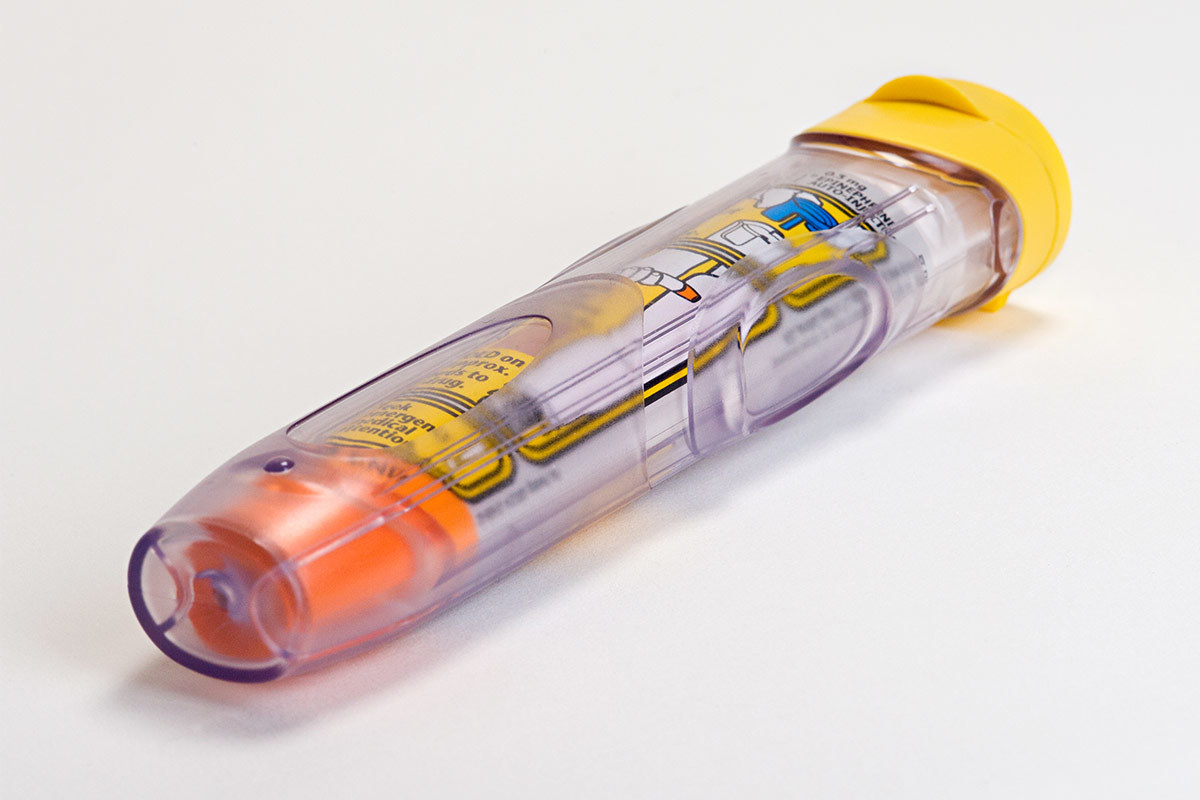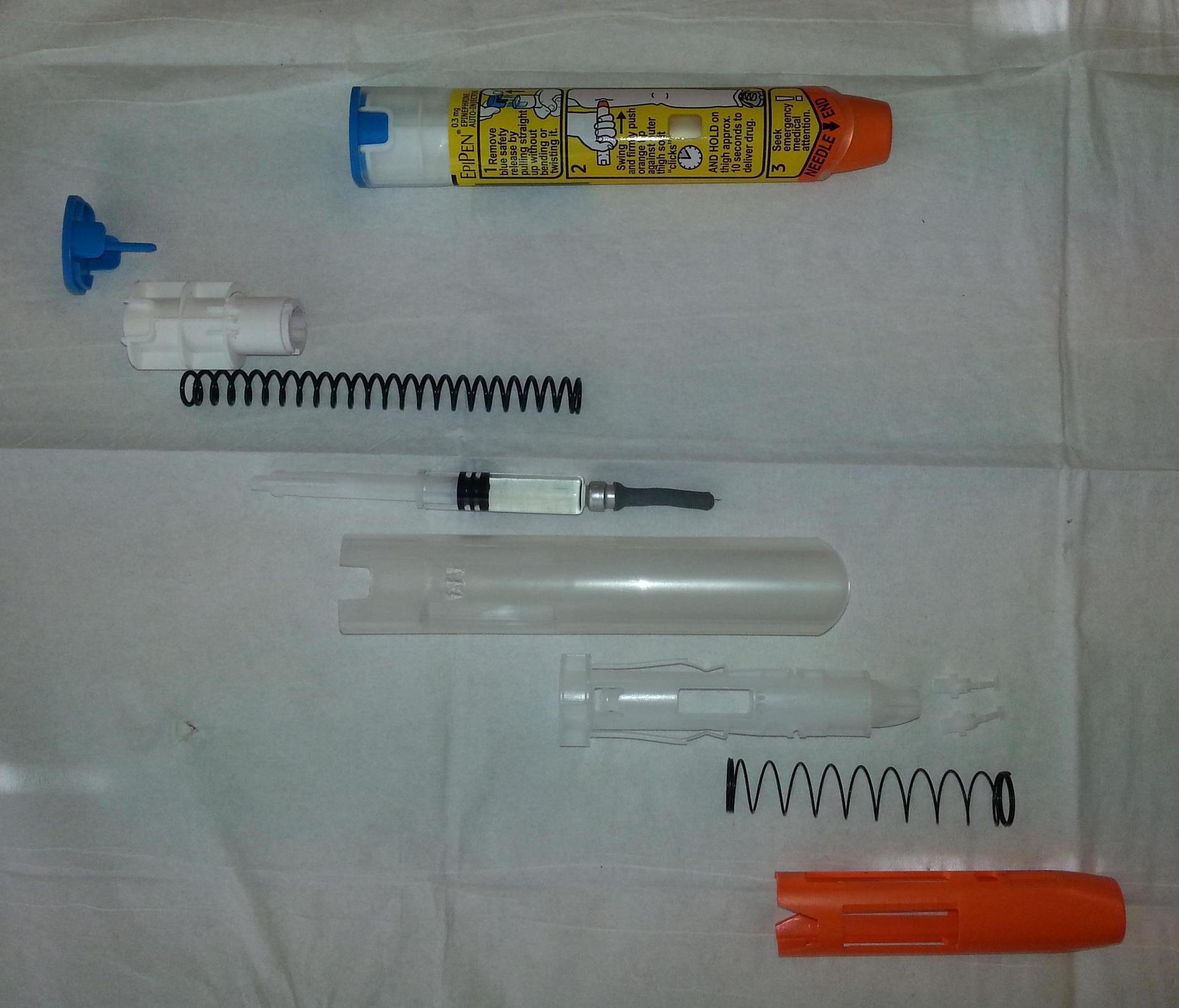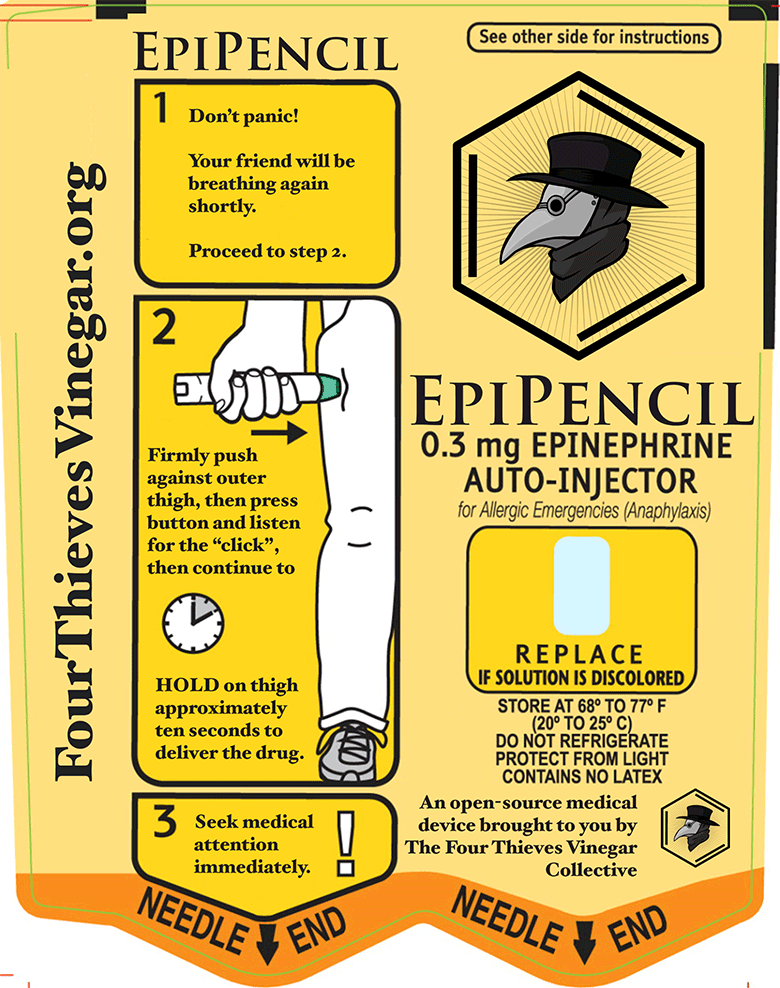DIY enthusiasts have collected autoinjector, analog EpiPen, for $ 28.50

Self-made EpiPencil for $ 30 works no worse than certified EpiPen worth $ 304.4
A month ago, the public was outraged that the pharmaceutical company Mylan had once again increased the cost of a patented drug, which is vital for people suffering from severe allergies. We are talking about an EpiPen syringe tube (EpiPen) with epinephrine - a solution for emergency intramuscular injections in the event that a person has anaphylactic shock.
When the EpiPen hit the market in 2007, pharmacies paid less than $ 100 for a set of two syringes. Since then, the price for pharmacies has grown steadily and in May 2016 reached $ 608.61.

EpiPen syringe in a case
')
In the comments to the topic, people expressed reasonable doubts that the cost of this device can not be so high. Most of the plastic parts of the EpiPen syringe tube can be printed on a 3D printer. Plus a few springs and an epinephrine ampoule.

Most of the plastic parts of the EpiPen syringe tube can be printed on a 3D printer
The patented EpiPen design allows you to stick the syringe and inject the medicine even in a semi-conscious state. You need to grab the syringe tube, remove the fuse - and just stick the yellow cover in your leg or arm. The needle will automatically come out of the cap and enter the body, and synthetic adrenaline is injected under the skin.
A month after the last price increase, the first samples of home-made devices finally appeared.
Several DIY enthusiasts founded the group Four Thieves Vinegar , which aims to develop a variety of medical devices for self-production .
First of all, the group Four Thieves Vinegar has developed a design of an automated laboratory reactor that can be made from scrap materials and used to synthesize medicines. The plan of the self-made Apothecary MicroLab is available for download via a direct link and via torrent .
On September 19, the hacker group announced the development of a home-made autoinjector EpiPencil , an analogue of the EpiPen. Instructions for the manufacture of this product is also available for download at a direct link and via torrent .
Hackers offer to buy three low-cost parts:
- Reusable device for automatic injection Autoinject 2 # AJ1311 - $ 27.99 (sold in Russia for 2162 rubles)
- Sterile 1cc Luer Slip Tip Syringes (pack of 10) - $ 2.49
- Disposable hypodermic needles 1 ”22G Luer Lock (pack of 100 pieces) - $ 4.95
- Epinephrine (synthetic adrenaline) bottle
After that, it is necessary to assemble an autoinjector in accordance with the instruction, print it out and paste the application instruction onto the device.

Video instruction for autoinjector assembly
The cost of components for the assembly of a self-made autoinjector is $ 28.29 ($ 27.99 + $ 0.25 + $ 0.05 = $ 28.29), plus the cost of epinephrine itself, which is sold in Moscow pharmacies at a price of 76-84 rubles for 2 ml .
One injection requires from 0.15 to 0.3 ml, depending on the severity of anaphylactic shock. The original EpiPen is sold with two autoinjectors for 0.15 ml and 0.3 ml. In this case, it is recommended to fill the device immediately with 0.3 ml. Thus, the cost of one dose of epinephrine is 12-14 rubles, and the total cost of an autoinjector rises to $ 28.50 , at the rate of September 22, 2016 at 12:35 it is 1820.71 rubles.
Available medicines are a very topical issue for the United States, where the cost of treatment has grown to fantastic values (because the insurance company usually pays for everything). This also applies to the cost of drugs, and the cost of services. For example, the ambulance call alone costs from $ 400 (in Washington) to $ 900 (in Chicago) , plus payment per kilometer to the hospital, so that poor people with broken legs prefer to get to the hospital under their own power if they don’t insurance. For drugs worth several hundred dollars, some Americans travel to Canada or Cuba, where these drugs are sold for one or two dollars .
The sharp rise in price of the EpiPen autoinjector has led to the fact that now not every parent can buy a saving syringe for a child by sending him to school. Not every medical insurance covers EpiPen, and not all Americans have it.
Homemade autoinjector - one of the options how to save the situation. Of course, such home-made products will never be certified by the Food and Drug Administration (FDA) and will not be available for sale. But if a person has no other choice, then making an autoinjector with epinephrine may be an acceptable option, especially since there is nothing complicated about it.
Epinephrine was synthesized more than 100 years ago, it is not subject to the legislation on the protection of intellectual rights. The patent for the basic design of the syringe tube was issued in 1977 and also expired, so copying that design would not be a violation of intellectual property rights. In 2005, the company Mylan prudently received a new patent for a specific slightly modified design of a syringe tube, which is valid for 20 years, that is, until 2025. The main innovation in the new patent is the bright orange cap , which closes the needle and instantly opens the spring when the cap is pressed against the body. Experts say that it is difficult for competitors to offer another design for the device of such functionality, and the cap with a spring is already patented by Mylan. There is practically no special technical difficulty here, the problem is only in a patent that you do not violate, making a medical device for personal use, not selling.
Myflane manufactures syringe tubes for Mylan, and so the pharmaceutical company makes almost all its intellectual property.
Source: https://habr.com/ru/post/397677/
All Articles